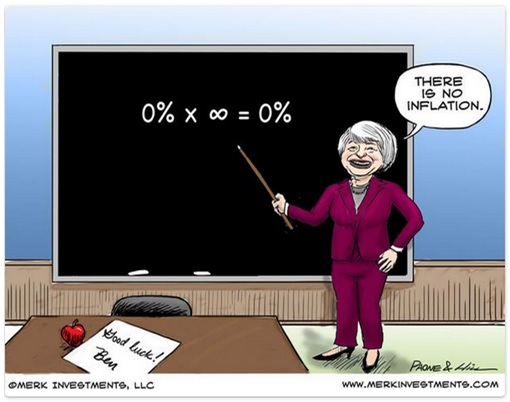BOMBSHELL – THE CHICKENS COME HOME TO ROOST ON SENILE JOE BIDEN’S HEAD – STILL IN DREAMLAND ABOUT ‘WHUPPING’ RUSSIA & CHINA – ‘WASHINGTON STILL HASN’T FIGURED OUT THAT AS LONG AS UKRAINE WAR DOESN’T END, INFLATION WILL REMAIN HIGH DUE TO HIGH ENERGY PRICES & SHORTAGE OF SUPPLY’ – THE FACTS NOW CONFIRM WITH CERTAINTY IT IS THE U.S. GOVT’S MONEY PRINTING THAT IS THE ROOT CAUSE OF GLOBAL INFLATION, EXACERBATED BY THEIR PROXY WAR AGAINST RUSSIA – MAKE NO MISTAKE, A GIGANTIC CRASH IS COMING THANKS TO AN IRRESPONSIBLE & POWER-CRAZED WASHINGTON!
SVB & Signature Banks Collapse – Here’s Why The U.S. Panics And How The Crisis Could Spread To Around The World
Silicon Valley Bank (SVB) said on Wednesday (March 8) that it would like to raise some funds – US$2.2 billion to be precise. Investors as well as venture capitalists were surprised that the bank – 16th biggest in the United States, with US$209 billion in assets – suddenly needed so much money. Within 48 hours, the bank had collapsed, ending its 40-year banking business.
On Friday, California banking regulators closed the bank and promptly appointed the Federal Deposit Insurance Corporation (FDIC) as receiver. SVB’s failure is the largest since Washington Mutual (US$300 billion in assets) went bust in 2008 during the Global Financial Crisis, which in turn was the most serious financial crisis since the Great Depression (1929-1939).
If you still had no clue whatsoever how did the bank go bust so quickly, it’s the same drama that you have watched on TV. People panicked and started withdrawing their hard-earned money from the bank. The run on the bank – withdrawing money at the same time – because depositors feared that Silicon Valley Bank will become insolvent was the last straw that broke the camel’s back.
![]()
The bank tried to raise capital to offset fleeing deposits, approximately US$21 billion of securities, which will result in US$1.8 billion losses. Worse, following a downgrade from Moody’s, Peter Thiel’s Founders Fund advised companies to pull their money out of SVB due to financial stability concerns, and it didn’t take much convincing for others to follow soon after.
SVB CEO Greg Becker made the mistake by asking customers to “stay calm” on Thursday, the same day US$42 billion was withdrawn as depositors interpreted the message as a crisis and ran for the exits. At the end of the business day, SVB had a negative cash balance of US$958 million. The share price of the bank tumbled 60% to US$106, before it was suspended. But it was just the beginning.
The crisis saw more than US$100 billion wiped out of the stock market value from U.S. banks within the 48 hours. European banks alone lost around US$50 billion in capitalization. Then came another bombshell – New York-based Signature Bank has also been forced to shut its doors. Signature Bank’s latest filings show it had US$110.4 billion in total assets and US$88.6 billion in total deposits.
While Silicon Valley Bank was established to specifically serve venture capitalists, Signature Bank was a favourite among the cryptocurrency industry. But both banks share a similar problem – more than 90% of the deposits were uninsured. Meaning 90% of US$175 billion in uninsured deposits of SVB would be up in smoke without any rescue or bailout plan.
The banking sector was not the only one panicking. The government was terrified at the prospect that the collapse of SVB could spread nationwide. Initially, U.S. Treasury Secretary Janet Yellen has rejected any form of bailout, only to make a U-turn when the Biden administration announced on Sunday night that all depositors of both banks would have access to all their money on Monday morning.
The FDIC’s standard insurance covers up to only US$250,000 per depositor, per bank, for each account ownership. However, SVB is not any ordinary banks for average Joes and Janes. Its customer base spanned from top-tier venture to private equity firms. Founded in 1983 after a poker game, Silicon Valley Bank was an important engine for the tech industry’s success.
In fact, SVB provided the fuel – money – to more than 2,500 Venture Capitalist firms that burned millions of dollars every month. For example, Roblox Corp held 5% of its US$3 billion in cash at the bank, while streaming device maker Roku Inc had US$487 million in deposits at the bank. Crypto firm Circle revealed it had US$3.3 billion cash with SVB, with remainder US$40 billion held elsewhere.
Clearly, the US$250,000 insurance coverage isn’t enough, especially smaller start-ups which needed cash for payroll and other immediate needs. They might be forced to lay off workers if their money held by the bank was frozen or lost. Already, tech companies in the U.S. have experienced months of plunging stock prices and tens of thousands of layoffs.
The flip-flop in its decision to ultimately protect the assets of tech firms, venture capitalists, and other rich people in California has seen criticisms fired on the U.S. government. But if Biden administration refused to rescue them, it could trigger “systemic meltdown” and brings down the entire U.S. banking system with it. SVB constitutes about half of total U.S. Venture Capitalist firms.
Senator Bernie Sanders said – “Now is not the time for U.S. taxpayers to bail out Silicon Valley Bank. If there is a bailout of Silicon Valley Bank, it must be 100 percent financed by Wall Street and large financial institutions. We cannot continue down the road of more socialism for the rich and rugged individualism for everyone else.” That’s easier said than done.
Unless there’s another bank willing to buy Silicon Valley Bank, the only way to rescue the depositors – and to prevent a banking crisis that would cripple the U.S. economy – is for the government to bail out the bank. Some economists and analysts have argued that SVB is just a midsize bank that was badly managed, hence there won’t be any systemic event.
After all, the U.S. top-5 biggest banks have almost US$13 trillion in assets. But you cannot control the emotional – fear – among customers of other banks about their money. Already, crypto bank Silvergate has just gone bust. Gone were the days you had to physically go to a bank to withdraw your money. Today, you can transfer your money online in a matter of seconds.
Regardless how much assets the biggest banks have, the reality is none has enough cash to return to depositors if all of them withdraw simultaneously. Banks make money by charging a higher rate on loans and overdrafts than they offer to savers who deposit money in bank accounts. Naturally, banks would lend as much money as possible to maximise profits, leaving very little cash.
Like the dot-com boom – and bust – in the 1990s, the “start-up boom” started after the 2008 financial crisis, where Silicon Valley Bank grew rapidly. And it did extremely well because conventional banks wouldn’t loan startups money. SVB actually lent against expected revenue for future services – even offered venture debt. In return, SVB would get slices of companies as part of its credit terms.
Its deposits grew from US$60 billion in 2020 to nearly US$200 billion two years later as the tech industry exploded during the Covid-19 pandemic, during which millions work from home. Companies that raised money from venture capitalists deposited it with the bank. Sometimes, even venture capitalists raised money from Silicon Valley Bank.
So, how did SVB screw-up do spectacularly? Flushed with so much money, the bank invested in debt like U.S. Treasuries and mortgage-backed securities. However, as the Federal Reserve increased interest rates to combat the highest inflation in 40 years, raising money has become more costly and the market for IPOs (initial public offerings) began to dry up.
To stay afloat, some SVB clients started pulling money out of the bank and eventually the bank itself runs out of capital. When interest rates were near zero, Silicon Valley Bank bought tonnes of Treasuries. Higher interest rates mean the value of those I.O.U. papers has fallen, leaving the bank sitting on unrealized losses. But it’s not all the bank’s fault.
Why did the Fed adopt an aggressive interest rate hike monetary policy in the first place? While Biden administration conveniently blames Russian president Vladimir Putin for the current financial problems in the U.S. and the world, in reality, it was the United States that screwed up its own economy. And the person who had admitted that is none other than Janet Yellen.
In an interview with CNN, U.S. Treasury Secretary Janet Yellen said she was “wrong” about how severe inflation would be. She admitted her screw-up – “I think I was wrong then about the path that inflation would take”. She was referring to her remarks in 2021 where she indicated there would only be a “small risk” of inflation, and that it would be “manageable”.

Worse, she said something that was absolutely stunning – “There have been unanticipated and large shocks to the economy that have boosted energy and food prices, and supply bottlenecks that have affected our economy badly, that I didn’t at the time ‘didn’t fully understand’. But we recognize that now the Federal Reserve is taking the steps that it needs to take.”
The inflation didn’t start because Russia invaded Ukraine. For years, the Fed lied that the high inflation was not serious in order to justify an interest rate near zero because the White House wanted Americans to feel rich by allowing them to borrow and spend. Even before the pandemic, the Fed was responsible for flushing the financial markets with cheap money – about US$120 billion a month – since 2018.
At least US$6 trillion was printed to boost people’s savings during the pandemic. It was this money supply that led to inflation. The Fed had only rushed to raise interest rate after three consecutive months of hitting highest inflation in 40 years last year (Jan’s 7.5%, Feb’s 7.9% and Mar’s 8.5%). Worse, the Congress had approved a whopping US$113 billion in aid to Ukraine in 2022 alone.
Those money increase deficit spending, adding more debt to America’s existing massive US$31 trillion national debt. The new bailout of Silicon Valley Bank means more money will be printed. Now, the clueless Fed is trapped by its own incompetence and the United States is trapped by its own arrogance for power.They have to choose whether to save the financial system or the dollar.
If Washington wants to save the dollar, they will have to raise interest rates. To save the financial system, they will have to stop or loosen the rate hike, which might see inflation skyrockets again. The U.S. can only save one thing at a time. And the SVB bankruptcy could be just the tip of the iceberg. Chances are they will cut rates to save the system, meaning inflation will explode and leads to recession.
This is why the commodity prices, especially the gold, is skyrocketing now. And guess which countries have already loaded tonnes of gold – China and Russia. U.S. banks as well as international banks are getting crushed. The best part is the arrogant America still wanted to prolong the Ukraine War by sending weapons and at the same time provokes China for a war over Taiwan.
Washington still hasn’t figured out that as long as Ukraine War doesn’t end, inflation will remain high due to high energy prices and shortage of supply like fertilizer that worsens food inflation. The U.S. government is still in denial, believing that money printing does not cause inflation and can continue forever. Make no mistake – a crash is coming. The chickens have come home to roost.
FINANCE TWITTER
.
